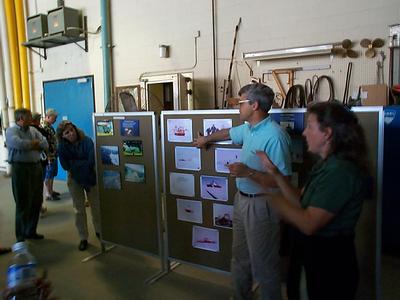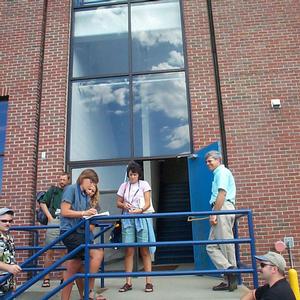
|
|
8 August, 2001
August 8, 2001
CRREL. It sounds like the name of an alien race from Star Trek. And a lot of very unusual
activities take place at CRREL, to be sure.
But it’s on Planet Earth, in rural central New Hampshire. A few minutes past Dartmouth
University, amidst placid cows and just down the road from the Slurpee machine at the crossroads
Quickie Mart, is one of the coldest places in the United States. And the cold is all indoors.
CRREL, the Cold Regions Research and Engineering Laboratory, is a place where scientists and
engineers make everyday things like bridges and roads very, very cold. Then they do very, very bad
things to them. They stress them and push them and try their best to make sense of the pieces. The
goal: to make bridges and roads and transportation systems perform better under the harsh winter
conditions of the Arctic & Antarctic. A plaque on a piece of lab equipment insists :”One test is
worth a thousand expert opinions.”
Our group of 12 pole-bound teachers wandered through CRREL on one of the hottest days of the
year. The scale of the facilities is enormous. In one of the largest sheds waited an immense blue
“heavy vehicle simulator”, capable of simulating 600 fully loaded trucks per hour over a stretch
of frozen asphalt. We stood astride deep grooves squished into the pavement during a previous
test, watching some very hot and tired workers dig up a gravel sub-pavement and pull up sensor
wires. Ultimately, a new piece of pavement will be laid down here, on top of a test piece of
synthetic “carpet” which may help the frozen asphalt to hold together. While we watched, the sun
came out from behind a cloud, and the metal rooftop crackled like bacon as it expanded. It was
hard to imagine freezing this roadway.
We hurried on, cheered by the promise of a visit to a room 24 degrees below zero. Up the stairs
and into the air conditioned library provided some relief, and we admired the mammoth tusk and the
large collection of hydrology, geology, military, engineering, and scientific journals. As an Army
Corps of Engineers research facility, CRREL’s collection reflects its broad civilian and military
missions, solving defense specific problems and fixing ice-related flooding throughout the
northern US.
The cold room met every expectation. Marge from Connecticut noticed ice crystals forming on my
shirt within moments after she closed the door behind us. Being a big guy, and with long pants on,
I wasn’t bothered, but the teachers dressed for hot weather, the sandals and shorts group, began
to hop around a little. Ice cores from Greenland sat in round metal cases, stacked to the ceiling
like firewood. Near where I stood, a shelf held about five hundred of those blue ice freezer
packs. I have one of those in my freezer at home.
We got a tour through the main test facility from smiling engineer Len Zabilinski. We were handed
off to Len at the entrance of a large garage, where Maria, the public relations officer, bowed out
because she’d developed some sensitivity to the strong ammonia smell permeating the building.
Ammonia is used as a refrigerant for this huge building, where Len supervises the scale modeling
of locks, barges, bridges, rivers, and, above all, ice.
Animated, Len spoke of successes at locks and bridges. Using small scale locks a person could
jump over, CRREL developed a bubblejet to clear ice from in front of barges, allowing locks to
work quickly year round.
Dams installed to control turbulence prevent ice from forming when supercooled water, ready and
waiting to turn to ice, is mixed when it passes over rapids and a kind of Slurpee ice rapidly
solidifies. This troublesome ice, called frazil ice, is ready and willing to stick to other ice
and bridges, and forms ice dams, sometimes within hours. Len showed us a swimming pool sized river
model which can be lined with sediment, filled with supercooled water, and tilted to create river
flow.
Len also spoke about less successful experiments. One trial involved placing pylons joined by a
common base in the model river. The camera crew had some technical difficulties, and by the time
they were ready to shoot, the ice had frozen to the pylons. When the water began to flow
downstream, the pylons suddenly created a dam. Water piled up behind the ice dam until the base
was lifted up and the entire apparatus was overturned. Oops. “That’s how we knew to make a really
solid base,” Len explained.
By modeling, and scaling up, CRREL researchers gradually develop solutions by understanding the
sensitivity between the variables in their systems. “The measurements sometimes are completely
different from what everyone thought was happening,” said Len. “But if the model starts to look
right, then we’re on the right track.”
CRREL does unique work.“It’s seat of the pants engineering : 1, 2, 3, give it a whirl. We’re
really out there by ourselves.”
=====
Eric Muhs
Physics Instructor
Seattle Academy of Arts & Sciences
www.invisiblemoose.net
__________________________________________________
Do You Yahoo!?
Make international calls for as low as $.04/minute with Yahoo! Messenger
http://phonecard.yahoo.com/

1. Cold Regions Research and Engineering Laboratories Engineer Len Zabilinsky elaborates on a project to strengthen superstructures against ice damage on the Coast Guard icebreaker Healy. A teacher was involved in this project and spent time on the icebreaker evaluating the performance of the new structures. American Sign language interpreter Virginia Husted translates for teacher Shannon Graham from the Washington State School for the Deaf, who is bound for the Arctic in the summer of 2002. ===== Eric Muhs Physics Instructor Seattle Academy of Arts & Sciences www.invisiblemoose.net __________________________________________________ Do You Yahoo!? Make international calls for as low as $.04/minute with Yahoo! Messenger http://phonecard.yahoo.com/

2.Engineer Len Zabilinsky delivers pithy quotes, while teachers scribble furiously in their notebooks. Eventually, these notes will find their way into daily journals posted on the TEA website, to be read by students, family, and friends. Teachers from all over the United States parcticipate in TEA (Teachers Experiencing the Arctic & Antarctic). TEA opens doors into research in the polar regions, and supports teachers in bringing their experiences back into their classrooms and communities. ===== Eric Muhs Physics Instructor Seattle Academy of Arts & Sciences www.invisiblemoose.net __________________________________________________ Do You Yahoo!? Make international calls for as low as $.04/minute with Yahoo! Messenger http://phonecard.yahoo.com/

3.TEA teachers straddle a rut in asphalt created by a "heavy vehicle simulator". This mammoth machine can mimic the destructive effects of hundreds of fully loaded trucks per hour over a stretch of frozen highway. Through repeated experiments like this,CRREL engineers hope to learn how to build polar roads that last longer and are less expensive. ===== Eric Muhs Physics Instructor Seattle Academy of Arts & Sciences www.invisiblemoose.net __________________________________________________ Do You Yahoo!? Make international calls for as low as $.04/minute with Yahoo! Messenger http://phonecard.yahoo.com/
Contact the TEA in the field at
.
If you cannot connect through your browser, copy the
TEA's e-mail address in the "To:" line of
your favorite e-mail package.
|
